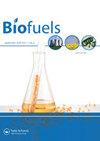Study of the addition of Gabiroba leaves extract in the biodiesel oxidation reaction in the presence of metal ions
IF 2.6
4区 工程技术
Q3 ENERGY & FUELS
引用次数: 0
Abstract
Abstract Biodiesel is considered a renewable energy source, making it possible to reduce the use of fossil fuels and the emissions of gasses derived from sulfur oxides. It is one of the alternatives to diesel due to its similar physicochemical properties. However, this biofuel contains unsaturated methyl esters in its composition, which makes it susceptible to oxidation. Among the factors that alter its chemical stability is its contamination by transition metal ions. This study aimed to evaluate the influence of Cu2+, Fe2+ and Fe3+ ions in the oxidative stability of biodiesel using Gabiroba leaves extract as a natural antioxidant. Metal ions were added to biodiesel in the presence and absence of the extract to evaluate their effect in the induction period and the kinetics and thermodynamic parameters of the oxidation reaction. The Gabiroba leaves extract inhibited the catalytic action of Fe2+ and Cu2+ cations in biodiesel, but this effect was not observed with Fe3+. The thermodynamic parameters of the reactions evaluated by the Eyring equation, based on the activated complex theory, indicated that in all cases the process was non-spontaneous and endothermic: ΔG‡ > 0, ΔH‡ > 0, and negative ΔS‡ values.在金属离子存在的条件下,研究加滨螺叶提取物在生物柴油氧化反应中的作用
摘要生物柴油被认为是一种可再生能源,可以减少化石燃料的使用和硫氧化物气体的排放。由于其类似的物理化学性质,它是柴油的替代品之一。然而,这种生物燃料的成分中含有不饱和甲酯,这使其容易被氧化。改变其化学稳定性的因素之一是其被过渡金属离子污染。本研究旨在评估Cu2+、Fe2+和Fe3+离子对Gabiroba叶提取物作为天然抗氧化剂的生物柴油氧化稳定性的影响。在提取物存在和不存在的情况下,将金属离子添加到生物柴油中,以评估它们在诱导期的影响以及氧化反应的动力学和热力学参数。Gabiroba叶提取物抑制了Fe2+和Cu2+阳离子在生物柴油中的催化作用,但Fe3+没有观察到这种作用。根据活化络合物理论,通过Eyring方程评估的反应热力学参数表明,在所有情况下,该过程都是非自发和吸热的:ΔG†>0,ΔHа>0和负ΔSа值。
本文章由计算机程序翻译,如有差异,请以英文原文为准。
求助全文
约1分钟内获得全文
求助全文
来源期刊

Biofuels-Uk
Energy-Renewable Energy, Sustainability and the Environment
CiteScore
5.40
自引率
9.50%
发文量
56
期刊介绍:
Current energy systems need a vast transformation to meet the key demands of the 21st century: reduced environmental impact, economic viability and efficiency. An essential part of this energy revolution is bioenergy.
The movement towards widespread implementation of first generation biofuels is still in its infancy, requiring continued evaluation and improvement to be fully realised. Problems with current bioenergy strategies, for example competition over land use for food crops, do not yet have satisfactory solutions. The second generation of biofuels, based around cellulosic ethanol, are now in development and are opening up new possibilities for future energy generation. Recent advances in genetics have pioneered research into designer fuels and sources such as algae have been revealed as untapped bioenergy resources.
As global energy requirements change and grow, it is crucial that all aspects of the bioenergy production process are streamlined and improved, from the design of more efficient biorefineries to research into biohydrogen as an energy carrier. Current energy infrastructures need to be adapted and changed to fulfil the promises of biomass for power generation.
Biofuels provides a forum for all stakeholders in the bioenergy sector, featuring review articles, original research, commentaries, news, research and development spotlights, interviews with key opinion leaders and much more, with a view to establishing an international community of bioenergy communication.
As biofuel research continues at an unprecedented rate, the development of new feedstocks and improvements in bioenergy production processes provide the key to the transformation of biomass into a global energy resource. With the twin threats of climate change and depleted fossil fuel reserves looming, it is vitally important that research communities are mobilized to fully realize the potential of bioenergy.
 求助内容:
求助内容: 应助结果提醒方式:
应助结果提醒方式:


